Teaching Grammar 语法教学
- 格式:ppt
- 大小:666.50 KB
- 文档页数:63
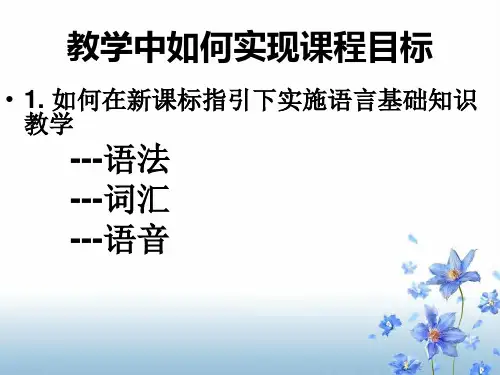
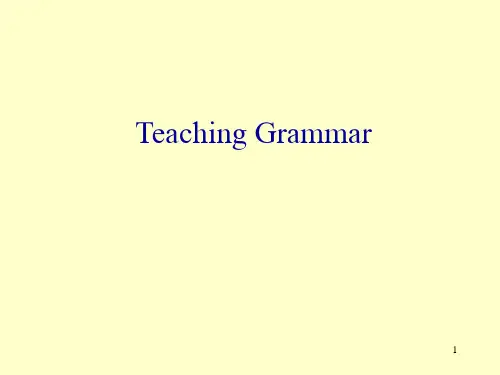
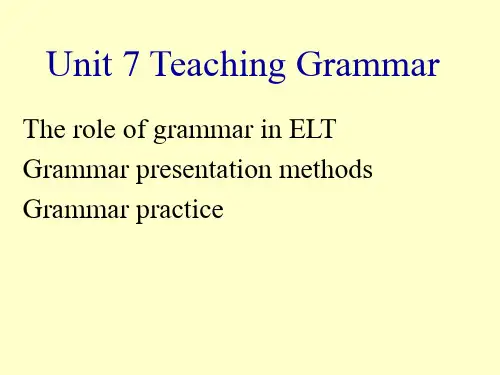
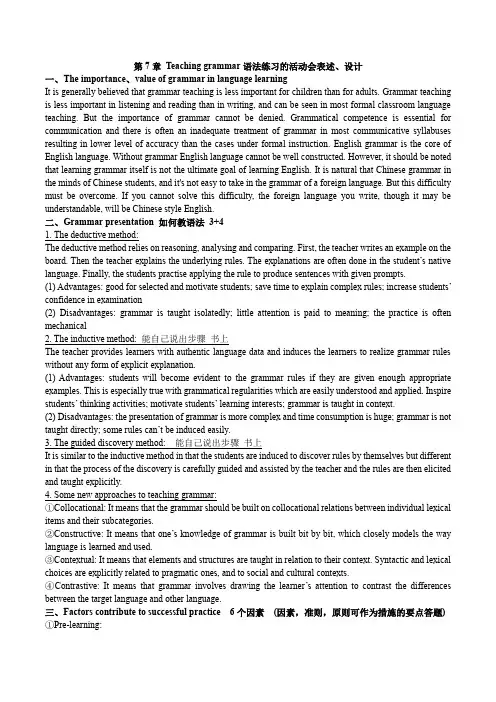
第7章Teaching grammar语法练习的活动会表述、设计一、The importance、value of grammar in language learningIt is generally believed that grammar teaching is less important for children than for adults. Grammar teaching is less important in listening and reading than in writing, and can be seen in most formal classroom language teaching. But the importance of grammar cannot be denied. Grammatical competence is essential for communication and there is often an inadequate treatment of grammar in most communicative syllabuses resulting in lower level of accuracy than the cases under formal instruction. English grammar is the core of English language. Without grammar English language cannot be well constructed. However, it should be noted that learning grammar itself is not the ultimate goal of learning English. It is natural that Chinese grammar in the minds of Chinese students, and it's not easy to take in the grammar of a foreign language. But this difficulty must be overcome. If you cannot solve this difficulty, the foreign language you write, though it may be understandable, will be Chinese style English.二、Grammar presentation 如何教语法3+41. The deductive method:The deductive method relies on reasoning, analysing and comparing. First, the teacher writes an example on the board. Then the teacher explains the underlying rules. The explanations are often done in the student’s native language. Finally, the students practise applying the rule to produce sentences with given prompts.(1) Advantages: good for selected and motivate students; save time to explain complex rules; increase students’ confidence in examination(2) Disadvantages: grammar is taught isolatedly; little attention is paid to meaning; the practice is often mechanical2. The inductive method: 能自己说出步骤书上The teacher provides learners with authentic language data and induces the learners to realize grammar rules without any form of explicit explanation.(1) Advantages: students will become evident to the grammar rules if they are given enough appropriate examples. This is especially true with grammatical regularities which are easily understood and applied. Inspire students’ thinking activities; motivate students’ learning interests; grammar is taught in context.(2) Disadvantages: the presentation of grammar is more complex and time consumption is huge; grammar is not taught directly; some rules can’t be induced easily.3. The guided discovery method: 能自己说出步骤书上It is similar to the inductive method in that the students are induced to discover rules by themselves but different in that the process of the discovery is carefully guided and assisted by the teacher and the rules are then elicited and taught explicitly.4. Some new approaches to teaching grammar:①Collocational: It means that the grammar should be built on collocational relations between individual lexical items and their subcategories.②Constructive: It means that one’s knowledge of grammar is built bit by bit, which closely models the way language is learned and used.③Contextual: It means that elements and structures are taught in relation to their context. Syntactic and lexical choices are explicitly related to pragmatic ones, and to social and cultural contexts.④Contrastive: It means that grammar involves drawing the learner’s attention to contrast the differences between the target language and other language.三、Factors contribute to successful practice 6个因素(因素,准则,原则可作为措施的要点答题)①Pre-learning:②V olume and repetition:③Success-orientation:④Heterogeneity:⑤Teacher assistance:⑥Interest:四、评述语法教学方法P115。
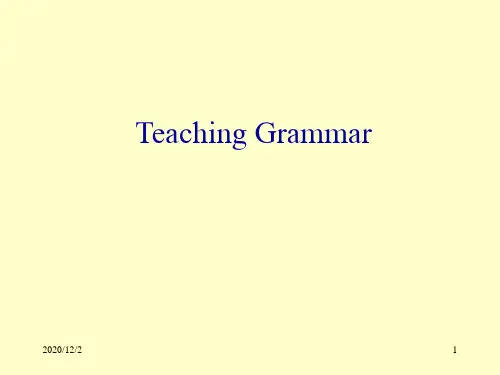
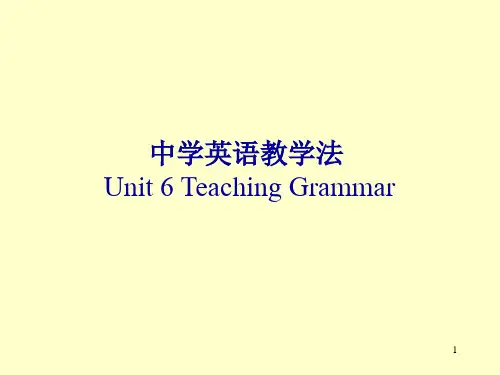
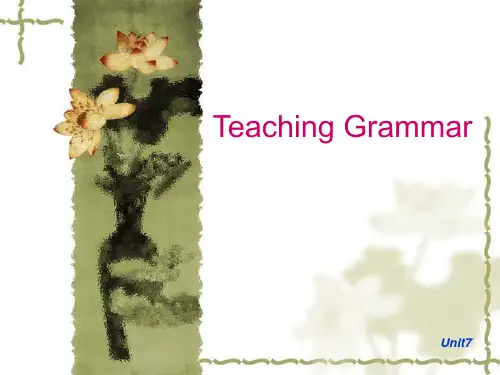
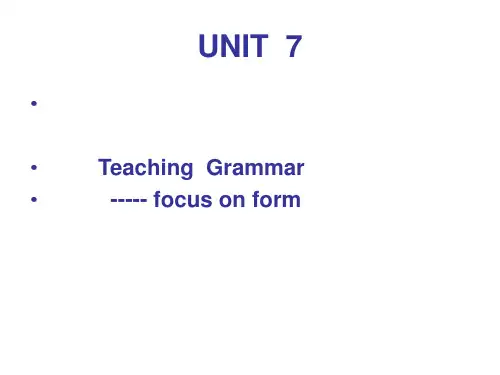

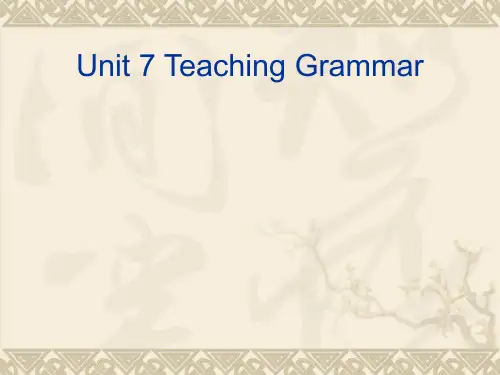
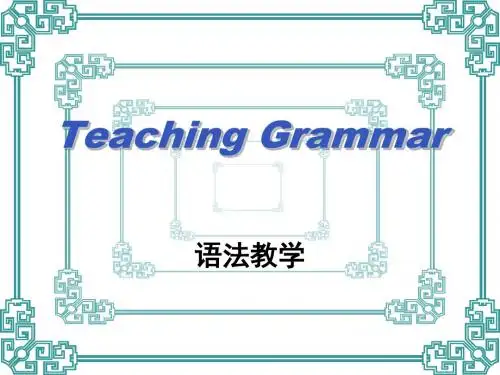
inductive和deductive语法教学
Inductive 和 deductive 是两种常见的语法教学方法。
Inductive grammar teaching(归纳法语法教学)是一种让学生通
过观察和分析大量的语言实例,自行归纳出语法规则的教学方法。
教
师提供各种语言材料,让学生自己发现和总结出其中的语法规则。
这
种方法强调学生的主动性和自主性,有助于培养学生的观察能力和分
析能力。
Deductive grammar teaching(演绎法语法教学)是一种教师先
直接讲解语法规则,然后让学生通过练习来应用这些规则的教学方法。
教师首先明确地陈述语法规则,然后提供相关的练习,让学生在实践
中加深对规则的理解和记忆。
这种方法能够帮助学生快速掌握语法规则,但可能会使学生在理解和应用上缺乏灵活性。
inductive 和deductive 两种语法教学方法各有优缺点,教师可以根据学生的特点和教学目标选择合适的方法,或者结合使用两种方法,以达到更好的教学效果。
Unit5 Grammar名师教学设计Book6 Unit5: The Power of Nature Section 3语法课框架单1/ 112/ 11Section 3语法课教学设计3/ 114/ 11DEL C3 深度加工知识Step 3Application(运用)1.Change the following sentences into the -ing form. Put the verbs intothe correct forms.(1)When Rose woke up in the middle of the night,she saw her roomwas as bright as day.(2)After we had stopped the car,we found ourselves trapped in thickfog and couldn't see clearly ahead.(3)Because I had spent all night reading the documents,I was verytired the next day.(4)As the child had never seen a rainbow before,he was very excited.Suggested answers:(1)Waking up in the middle of the night,Rose saw her room was asbright as day.(2)Having stopped the car,we found ourselves trapped in thick fog andcouldn't see clearly ahead.(3)Having spent all night reading the documents,I was very tired thenext day.(4)Having never seen a rainbow before,the child was very excited.2.Do Exercise 4 in Discovering useful structures on Page 37.First ask students to do the exercises individually and then let themdiscuss and check their answers with their partners,and finally give themthe correct answers and deal with any problems they might meet.1.在具体语境中运用ing形式作状语1.学生是否能在具体语境中掌握ing形式的用法5/ 11Exercises请用括号里所给动词的适当形式填空:1. _____ (live) in a southern city of China, I have never seen such a wonderful snow view.2. _____ (not grow) up yet, you’re not allowed to enter the bars.3. _____ (encourage) by the director, the actors performed wonderfully in the play.4. _____ (Know) all this, they made me pay for the damage.5. The students are sitting in the reading-room, _____ (read) all kinds of books. Key:1. Living2. Not having grown3. Encouraged4. Knowing5. reading二、单项选择1.The great hall was crowded with many people, _____ many children _____on their parents’ laps.A. including; seatedB. including; seatingC. included; satD. included; sitting2. _____ for a long time, most of the crops in this area died from lacking water.A. Being no rainB. There was no rainC. To be no rainD. There being no rain3.His letter, _____ to the wrong number, reached me late.4.A. having been addressed B. to have addressed5.C. to have been addressed D. being addressed4."You can't catch me" Janet shouted, ______away. (NMET2005全国卷3)A. runB. runningC. to runD. ran5.More and more people are signing up for Yoga classes nowadays, ______ advantage of the healthy and relaxation benefits. (NMET2005上海卷)6/ 11A. takingB. takenC. having takenD. having been taken6.______ in the queue for half an hour, Tom suddenly realized that he had left his wallet at home. (NMET2004北京卷)A. To waitB. Have waitedC. Having waitedD. To have waited答案1.A。
实用英语教学法教程-徐锦芬-Chapter 11 TeachinggrammarChapter 11: Teaching GrammarIntroduction:Teaching grammar is an essential component of language instruction as it helps learners understand the structure and rules of a language. This chapter will provide a detailed and precise guide on effective teaching methodsfor grammar instruction.1. Communicative Approach:- The communicative approach focuses on the use of language in real-life situations. Grammar is taught in context, and learners are encouraged to use grammar structures in meaningful communication.- Teachers can use authentic materials, such as newspaper articles or dialogues, to present grammar points. Learners can then analyze and practice the target grammar structure in these authentic contexts.2. Deductive Approach:- The deductive approach involves presenting learners with explicit grammar rules and explanations before providing them with practice activities.- Teachers can use charts, diagrams, or visual aids to present grammar rules. Learners can then apply these rules through controlled or guided practice activities.3. Inductive Approach:- The inductive approach involves presenting learners with examples of language use and allowing them to discovergrammar rules and patterns on their own.- Teachers can provide learners with a text or a set of sentences that contain the target grammar structure. Learners can then analyze these examples to identify the grammar rule or pattern.4. Task-Based Approach:- The task-based approach focuses on engaging learners in meaningful tasks that require the use of grammar structures. - Teachers can design tasks, such as role-plays or problem-solving activities, that prompt learners to use the target grammar in a realistic and purposeful way. This approach encourages learners to actively use grammar structures in context.5. Contextualized Grammar Instruction:- Contextualized grammar instruction involves teaching grammar within meaningful contexts, such as conversations, stories, or real-life situations.- Teachers can integrate grammar instruction into speaking, listening, reading, and writing activities. This helps learners understand how grammar structures are used in different language skills.6. Error Correction:- Error correction is an important part of teaching grammar as it helps learners identify and correct their mistakes.- Teachers can provide immediate or delayed error correction, depending on the purpose of the activity. They can also use various error correction techniques, such as self-correction, peer correction, or teacher correction.7. Scaffolded Practice:- Scaffolded practice involves providing learners with gradually increasing levels of support to practice and internalize grammar structures.- Teachers can start with controlled practice activities, where learners focus on accuracy and repetition. Then, they can move on to guided practice activities, where learners apply the grammar in slightly more open-ended tasks. Finally, learners can engage in communicative practice activities, where they use the grammar structure in meaningful communication.Conclusion:Teaching grammar requires a variety of approaches and techniques to cater to the diverse needs and learningstyles of learners. By using a combination of communicative, deductive, inductive, task-based approaches, and contextualized instruction, teachers can effectively teach grammar and help learners develop their language proficiency.。